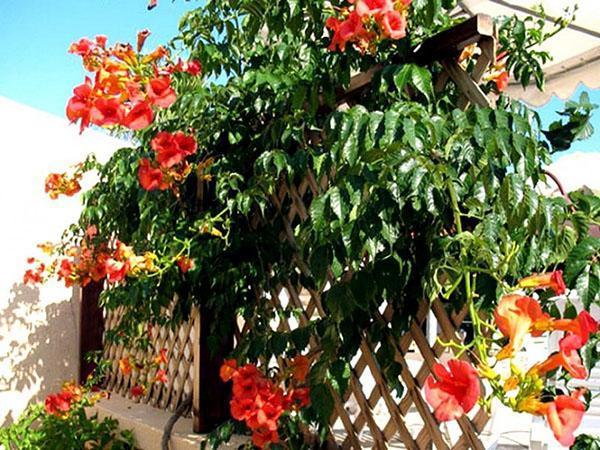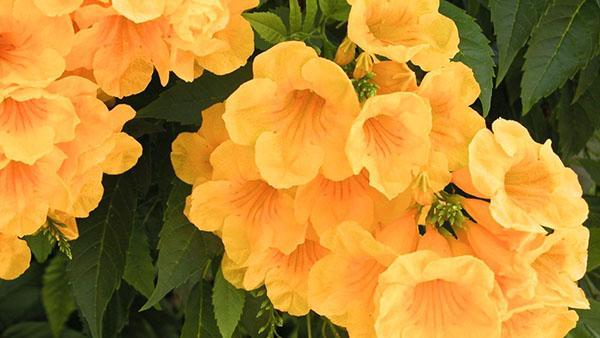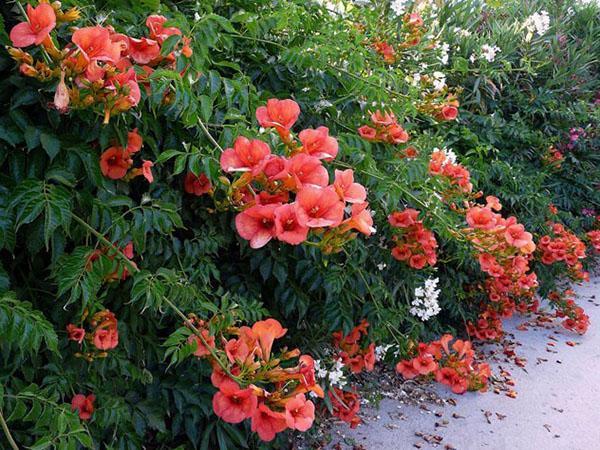Reproduction of Kampsis - an original way to create a paradise in the country
 You can hardly find a gardener who would refuse a cozy corner on his site. For many, planting several liana bushes at once has become a huge help in achieving this goal. Will accelerate the process of independent reproduction of kampsis. Quite often it is called a decorative liana with exquisite flowers that resemble gramophones. Bright inflorescences adorn gazebos throughout the summer or pergolas country houses. Why not grow such a miracle on the site? First, we will find out what attracts gardeners with this stylish vine. Then we will find out in what ways you can multiply it.
You can hardly find a gardener who would refuse a cozy corner on his site. For many, planting several liana bushes at once has become a huge help in achieving this goal. Will accelerate the process of independent reproduction of kampsis. Quite often it is called a decorative liana with exquisite flowers that resemble gramophones. Bright inflorescences adorn gazebos throughout the summer or pergolas country houses. Why not grow such a miracle on the site? First, we will find out what attracts gardeners with this stylish vine. Then we will find out in what ways you can multiply it.
Bright lights of Kampsis out of competition

 The plant is often grown for landscaping vertical structures on the territory of country houses. It is fixed to the support with the help of air roots, forming dense thickets. Therefore, those who are engaged in breeding Kampsis plant it in small groups. As a result, a charming place to relax appears in the country.
The plant is often grown for landscaping vertical structures on the territory of country houses. It is fixed to the support with the help of air roots, forming dense thickets. Therefore, those who are engaged in breeding Kampsis plant it in small groups. As a result, a charming place to relax appears in the country.
 The flower is characterized by complex feathery foliage, which consists of 7 or 11 plates. Each has a glossy surface with veins, jagged edges and a sharp tip. The foliage is dark green. It adorns a curly shoot that can reach up to 10 meters in length.
The flower is characterized by complex feathery foliage, which consists of 7 or 11 plates. Each has a glossy surface with veins, jagged edges and a sharp tip. The foliage is dark green. It adorns a curly shoot that can reach up to 10 meters in length.
 The main advantage of Kampsis is its bright flowers. They are expertly collected in small panicles and located at the ends of the curly stems. The buds are tubular, about 9 cm long and 5 cm wide. Their color depends on the variety. The most common colors are:
The main advantage of Kampsis is its bright flowers. They are expertly collected in small panicles and located at the ends of the curly stems. The buds are tubular, about 9 cm long and 5 cm wide. Their color depends on the variety. The most common colors are:
- Orange;
- yellow;
- pink;
- crimson;
- red;
- golden.
 Despite its attractiveness, the buds do not exude an odor, but are honey plant... They attract not only bees, but also ants, wasps and other insects. After pollination on the shoots, fruits are formed in the form of a leathery pod, consisting of 2 valves. Each of them ripens a huge number of seeds with original wings, which gardeners use to propagate kampsis in their plots. When the "storage" ripens, the winged seeds fly in different directions to find a fertile place for growth.
Despite its attractiveness, the buds do not exude an odor, but are honey plant... They attract not only bees, but also ants, wasps and other insects. After pollination on the shoots, fruits are formed in the form of a leathery pod, consisting of 2 valves. Each of them ripens a huge number of seeds with original wings, which gardeners use to propagate kampsis in their plots. When the "storage" ripens, the winged seeds fly in different directions to find a fertile place for growth.
Gardeners have noticed that not all types of creepers bear fruit. Probably, for this it is necessary to plant a copy belonging to another clone nearby.
Kampsis reproduction available for gardeners at their summer cottage
 To grow a decorative liana with bright bouquets of flowers, you need to understand the intricacies of its reproduction. She, like other plants, does not appear immediately in the form of a large bush. It takes a lot of work in order to create a blooming haven for the soul, on the territory of your favorite summer cottage. There are several ways how kampsis reproduces at home:
To grow a decorative liana with bright bouquets of flowers, you need to understand the intricacies of its reproduction. She, like other plants, does not appear immediately in the form of a large bush. It takes a lot of work in order to create a blooming haven for the soul, on the territory of your favorite summer cottage. There are several ways how kampsis reproduces at home:
- grafting;
- seeds;
- layering;
- root cavity.
Let us consider in more detail just some of them in order to apply a suitable option in practice.
A unique way - grafting
 This method of breeding creepers kampsis is considered a rather laborious process.But as a result, the gardener does not have to worry that young seedlings will suffer from bad weather, because rooting takes place in a cozy room. Gardeners use two options: using lignified or green twigs.
This method of breeding creepers kampsis is considered a rather laborious process.But as a result, the gardener does not have to worry that young seedlings will suffer from bad weather, because rooting takes place in a cozy room. Gardeners use two options: using lignified or green twigs.
 Summer residents who prefer the method of propagation of Kampsis by cuttings of a lignified nature almost always achieve success. Over time, lush thickets with bright colors appear on the sites. But first, gardeners pick up cuttings. In early spring, they cut off last year's healthy branches covered with small cracks. At the same time, a maximum of 3 leaves and the same number of buds are left on each cutting. Then they are placed in boxes with fertile soil. After 2.5 months, the rooted branches are planted on the site.
Summer residents who prefer the method of propagation of Kampsis by cuttings of a lignified nature almost always achieve success. Over time, lush thickets with bright colors appear on the sites. But first, gardeners pick up cuttings. In early spring, they cut off last year's healthy branches covered with small cracks. At the same time, a maximum of 3 leaves and the same number of buds are left on each cutting. Then they are placed in boxes with fertile soil. After 2.5 months, the rooted branches are planted on the site.
Do not plant all cuttings outside at once, as unforeseen whims of nature can damage young seedlings.
Kampsis can also be propagated with the help of green shoots, which are cut from the middle of the bush in early June. Then they are shortened on both sides, leaving a maximum of 3 sheets. The lower end of the shoot is moistened with a growth stimulator, after which it is planted in loose fertile soil. To prevent the cutting from being damaged by bright sunlight, it is advisable to choose a shaded area for it. The probability of survival is nine out of 10 seedlings.
The lower end of the shoot is moistened with a growth stimulator, after which it is planted in loose fertile soil. To prevent the cutting from being damaged by bright sunlight, it is advisable to choose a shaded area for it. The probability of survival is nine out of 10 seedlings.
Cuttings should be planted at an angle of approximately 45 °.
Propagation of kampsis by seeds
 This method of growing a vine in a summer cottage is considered one of the most difficult. The main reason is a rather troublesome process. In addition, a flower gives a suitable planting material only 8 years after planting in open ground. Despite this, enterprising gardeners successfully grow Kampsis from seeds at home by doing the following:
This method of growing a vine in a summer cottage is considered one of the most difficult. The main reason is a rather troublesome process. In addition, a flower gives a suitable planting material only 8 years after planting in open ground. Despite this, enterprising gardeners successfully grow Kampsis from seeds at home by doing the following:
- purchase high-quality planting material in the store;
- prepare containers with fertile soil;
- make small holes, the depth of which is not more than 1 cm;
- sowing seeds;

- poured abundantly with clean, settled water.
If the room temperature is at least 22 ° C, then the first shoots will appear in a month. From that moment on, various dressings are added to watering. When the third true leaf appears, the vine is planted on the street.
The seeds are stored at room temperature in a dark, well-ventilated place.
Simple rules for transplanting an exotic liana
 Experienced gardeners carefully study their territory before moving a plant to a new site. Since the vine comes from warm regions, it loves sunny places where there is an abundance of light. The soil should be fertile with a neutral environment.
Experienced gardeners carefully study their territory before moving a plant to a new site. Since the vine comes from warm regions, it loves sunny places where there is an abundance of light. The soil should be fertile with a neutral environment.
A planned transplant of Kampsis in the spring is performed after the frost ends. Potash fertilizer is added to the hole prepared in the fall (50x60). Next, a little sand is poured, then drainage and soil in which the seedling is placed.  Having carefully straightened the roots, they are covered with earth, and then compacted. Pour on top with clean water at room temperature. In a similar way, Kampsis is transplanted in the fall, if the buried layers have already taken root enough.
Having carefully straightened the roots, they are covered with earth, and then compacted. Pour on top with clean water at room temperature. In a similar way, Kampsis is transplanted in the fall, if the buried layers have already taken root enough.
As you can see, the exotic liana is successfully developing on the plots of many gardeners. Its curly foliage and bright bouquets of dozens of "gramophones" keep them cool until autumn. In its shadow, you can reflect on the future and appreciate the unique beauty of the environment.